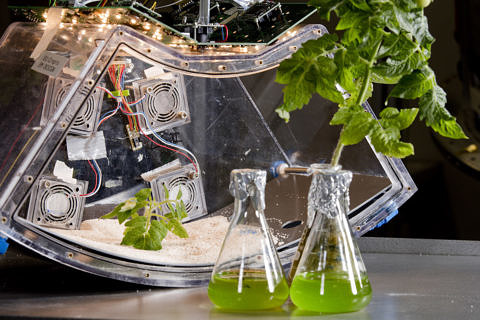Micro Tina venturing into space

FAU researchers investigate food sources for the astronauts of tomorrow
When people set off in future to explore the far reaches of the universe, astronauts will have to spend many months at a time in their spaceships on the way to far-off planets, and will need a reliable source of food. Researchers at Friedrich-Alexander-Universität Erlangen-Nürnberg (FAU) hope to gain valuable information from an experiment which is to be sent into space on board the European research satellite Eu:CROPIS, built by the German Aerospace Center (DLR). Update: the launch was planned for Monday 19 November 2018 with a Falcon 9 rocket from the Vandenberg Air Force Base in California. It has now been postponed. Further details below.
The team of researchers, consisting of the FAU biologists PD Dr. Michael Lebert and his working group together with Dr. Jens Hauslage from DLR, want to find out whether people can be self sufficient even at low gravity and whether a solution can be found to the questions and challenges faced by astronauts on the relatively short journeys they have undertaken to date, questions such as: How can we supply enough drinking water for such a long journey? Where should urine go? Can astronauts grow fresh vegetables for themselves?
On 19 November, they are to send twelve tomato seeds into orbit on board the Eu:CROPIS research satellite to investigate whether they can grow and bear fruit at low gravity in a closed ecosystem consisting of a water tank, a greenhouse, an algae container and a filter.
Food from waste products
The seeds and later on the plants are fertilised every few days with urine, in this case – as no passengers are on board – with artificial urine. Urine contains urea, which breaks down into ammoniac. Using a filter, this is converted into nitrate, which can be used to fertilise the plants. If the filter cannot cope, Euglena gracilis cells take over part of the work and protect the system from becoming swamped in too much ammoniac. The idea behind the system is to use a waste product to produce fresh food. The water in the urine is transpired by the tomatoes and can be regained from the air in its pure form, and there is no need to pack fertiliser – a major advantage when every gram counts and only the bare necessities can be packed.
The barrel-shaped compact satellite, which is approximately one metre high and one metre in diameter, will rotate around its own axis while in orbit at a height of approximately 600 kilometres. This generates gravity in the satellite, similarly to on a swing carousel, where you can feel yourself being pressed into your seat. In this way, the scientists hope to simulate the gravity on the moon for a period of six months, followed by gravity on Mars for a further six months.
Tomatoes for astronauts
‘Micro Tina’ is the tomato variety which has been chosen for the journey. It grows quickly, but stays small and produces fruit which still tastes good. ‘It is really important for astronauts, who have to depend on dried food for so long, to be able to have some fresh food at least now and again,’ says Michael Lebert. Maybe some time in the future Micro Tina will grow and thrive in a greenhouse on the red planet.
The planned launch on 19 November 2018 was postponed by SpaceX as the launch rocket had to be inspected again. A new launch date has not yet been arranged. The DLR will keep us up to date. The latest information is available on the SpaceX Twitter channel.
More information on the launch:
German Aerospace Center (DLR) website
Further information:
Go to the project’s Facebook page
On Twitter: #EuCROPIS
PD Dr. Michael Lebert
Phone: +49 9131 88217
michael.lebert@fau.de
Dr. Sebastian M. Strauch
Phone: +49 9131 8528222
sebastian.m.strauch@fau.de
Researchers from Friedrich-Alexander-Universität Erlangen-Nürnberg (FAU), Division of Cell Biology, and the Institute for Aeronautical and Aerospace Medicine at the German Aerospace Center (DLR) will launch a satellite with a greenhouse on board into space. They want to find out how compact life support systems can be used for long-term missions and how organisms react to reduced gravity over an extended period of time. Microalgae are helping to produce fertiliser which can then be used to ripen tomatoes.
(Image: FAU/Kurt Fuchs)